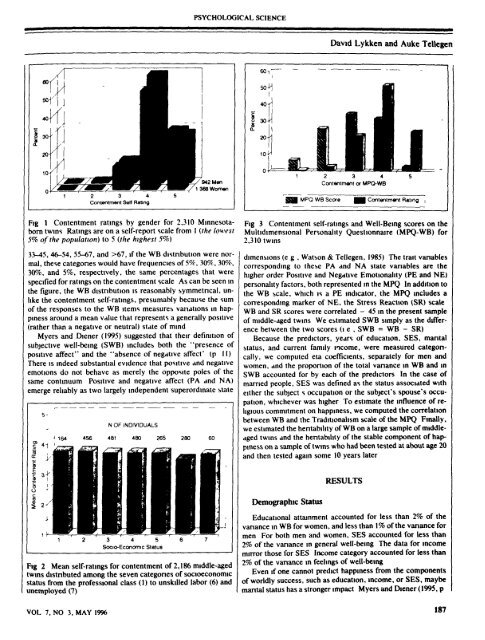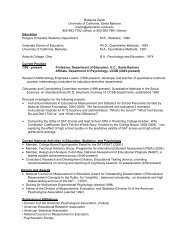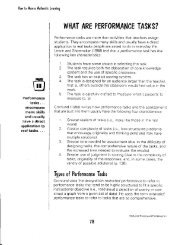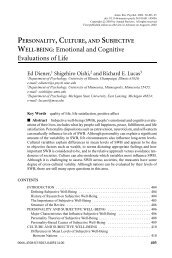happiness is a stochastic phenomenon - Gevirtz School of Education
happiness is a stochastic phenomenon - Gevirtz School of Education
happiness is a stochastic phenomenon - Gevirtz School of Education
You also want an ePaper? Increase the reach of your titles
YUMPU automatically turns print PDFs into web optimized ePapers that Google loves.
Fig 1 Contentment ratings by gender for 2,310 Minnesotabom<br />
twins Ratings are on a self-report scale from I {the lowest<br />
5% <strong>of</strong> the population) to 5 (the highest 5%)<br />
PSYCHOLOGICAL SCIENCE<br />
David Lykken and Auke Tellegen<br />
33^5, 46-54, 55-67, and >67, if the WB d<strong>is</strong>tnbution were nor- dimensions (e g , Watson & Tellegen, 1985) The trait variables<br />
mal, these categones would have frequencies <strong>of</strong> 5%, 30%, 30%, corresponding to these PA and NA state vanables are the<br />
30%, and 5%, respectively, the same percentages that were higher order Positive and Negative Emotionality (PE and NE)<br />
specified for ratings on the contentment scale As can be seen m personality factors, both represented in the MPQ In addition to<br />
the figure, the WB d<strong>is</strong>tribution <strong>is</strong> reasonably symmetrical, un- the WB scale, which <strong>is</strong> a PE indicator, the MPQ includes a<br />
like the contentment self-ratings, presumably because the sum corresponding marker <strong>of</strong> NE, the Stress Reaction (SR) scale<br />
<strong>of</strong> the responses to the WB items measures variations in hap- WB and SR scores were correlated - 45 in the present sample<br />
piness around a mean value that represents a generally positive <strong>of</strong> middle-aged twins We estimated SWB simply as the differ-<br />
(rather than a negative or neutral) state <strong>of</strong> mmd<br />
ence between the two scores (i e , SWB = WB - SR)<br />
Myers and Diener (1995) suggested that their definition <strong>of</strong> Because the predictors, years <strong>of</strong> education, SES, mantal<br />
subjective well-being (SWB) includes both the "presence <strong>of</strong> status, and current family income, were measured categori-<br />
positive affect" and the "absence <strong>of</strong> negative affect' (p II) cally, we computed eta coefficients, separately for men and<br />
There <strong>is</strong> indeed substantial evidence that positive and negative women, and the proportion <strong>of</strong> the total variance in WB and in<br />
emotions do not behave as merely the opposite poles <strong>of</strong> the SWB accounted for by each <strong>of</strong> the predictors In the case <strong>of</strong><br />
same continuum Positive and negative affect (PA and NA) mamed people, SES was defined as the status associated with<br />
emerge reliably as two largely independent superordinate state either the subject s occupation or the subject's spouse's occupation,<br />
whichever was higher To estimate the influence <strong>of</strong> religious<br />
commitment on <strong>happiness</strong>, we computed the correlation<br />
between WB and the Traditional<strong>is</strong>m scale <strong>of</strong> the MPQ Finally,<br />
N OF INDIVIDUALS<br />
we estimated the hentability <strong>of</strong> WB on a large sample <strong>of</strong> middleaged<br />
twins and the hentability <strong>of</strong> the stable component <strong>of</strong> <strong>happiness</strong><br />
on a sample <strong>of</strong> twins who had been tested at about age 20<br />
and then tested again some 10 years later<br />
Socio-Ecoromic Status<br />
Fig 2 Mean self-ratmgs for contentment <strong>of</strong> 2,186 middle-aged<br />
twins d<strong>is</strong>tnbuted among the seven categones <strong>of</strong> socioeconomtc<br />
status from the pr<strong>of</strong>essional class (1) to unskilled labor (6) and<br />
unemployed (7)<br />
VOL 7, NO 3, MAY 1996<br />
Fig 3 Contentment self-ratings and Well-Being scores on the<br />
Multidimensional Personality Questionnaire (MPQ-WB) for<br />
2,310 twins<br />
Demographic Status<br />
<strong>Education</strong>al attainment accounted for less than 2% <strong>of</strong> the<br />
vanance in WB for women, and less than 1% <strong>of</strong> the vanance for<br />
men For both men and women, SES accounted for less than<br />
2% <strong>of</strong> the vanance in general well-being The data for income<br />
mirror those for SES Income category accounted for less than<br />
2% <strong>of</strong> the vanance m feelings <strong>of</strong> well-being<br />
Even if one cannot predict <strong>happiness</strong> from the components<br />
<strong>of</strong> worldly success, such as education, income, or SES, maybe<br />
mantal status has a stronger impact Myers and Diener (1995, p<br />
187





